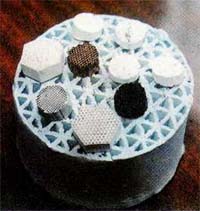Degradation properties of catalysts
It has been observed if to add to a catalyst substances are not catalysts, then it can has influence to the rate of reaction (i.e., to determine the effectiveness of the catalyst in chemical reactions). Substances that increase it ratio, — promoters are usually have a high melting point and their crystal structure similar to the structure of the catalyst. But the substances that impairing the catalytic properties, are catalytic poisons even low-melting or volatile.
It is interesting that toxic substances are for a living organisms (hydrogen sulfide, cyanide, mercuric chloride, etc.) generally are catalytic poisons. Degradation properties of catalysts with the influence of additives was called "poisoning of catalysts" as the analogy. "Poisoning" is because "poison" can strongly bind to the catalyst surface and "overshadows" her from the reactants. However, a number of experiments shows that the catalyst stops working long before the whole surface is blocked with a catalytic poison, for example to "poisoning" the iron catalyst, used for ammonia synthesis, it is enough to block only 0.1% of its surface.
In 1925, English chemist Hugh Stott Taylor (1890-1974) proposed the theory of active centers catalysis, designed to explain the data for "poisoning" of catalysts. He suggested that the catalysis involved not the whole surface, but only some of its sections, called active centers.
Theory of active centers clarified the mechanism of action of promoters and "poisoning" of catalysts. Catalytic poisons block the surface (and the active centers), but promoters stabilize or increase its size and surface. For example, a small amount of impurities in the material impede its crystallization: instead of large crystals are formed small, that have a large area of surface, i.e. the surface area to unit of volume or to unit of mass. In addition, it was found with the influence of the additives vary the number of active centers and their energy of adsorption. Active centers are characterized by a very high adsorption energy, i.e., reactant (a substance entering into a chemical reaction) "sticks" to them much easier than to other places. But among active centers are more "strong", able to attract more then one or two, three, molecules of the reagent. They are called multimolecular centers of catalysis.

Properties of catalysts

Properties of catalysis does not always obey the rule "two and two is four". For example, if you put the thin layer of catalyst to inactive substance in the catalysis, then the same way to prepare another catalyst and mix them, it is logical to expect that the catalytic activity of this mixture will be the arithmetic mean. But in fact, the acceleration of the reaction frequently exceeds expected! The result of addition is greater than the sum of its parts. This phenomenon is called synergies (from gr. "synergy" — "cooperation", "assistance").
Another interesting and important property — conjugation reactions. In particular, if the catalytic reaction release the energy, this energy can not dissipate, and be spent "for the benefit" to thermodynamically unfavorable processes. For example, a each person exists, because the energy generated at the oxidation of carbohydrates and processes of synthesis of proteins and other essential body substances occur in the cells (with energy absorption) .
To explain these and other unusual phenomena, instead of dealing with the chemical reactions and catalyst separately, it needs to study the catalytic system as a whole system, i.e. the process. This process includes initial substance and products, catalysts, area, size and condition of the surface, promoters, solvent, elementary reaction stages, the flow of reactants and withdrawal of products, and much more. This approach to the study of problems called systemic.
Efficiency of catalysts
As active centers of catalysts are located on the surface of the catalyst, for greater effect it is necessary to increase the catalyst surface, that is to grind it up.
But we must consider also usability of catalysts. For greater effect to get the desired reaction products as the catalyst is selected a porous substance with a large surface area.
The alternative to this convenience is the use catalyst carriers, which in turn can also effectively participate in chemical reactions. Catalyst carriers is material with a large surface area that has a very thin layer of catalyst. In some cases, the catalyst carriers may even change the way of the reaction. For example, if barium sulfate plating with palladium (here barium sulfate is the carrier), the substance can be used as a platinum catalyst, and if chalkplating with palladium – catalyst will exhibit the properties of nickel! Accordingly, in the reactions we will get various chemical reaction products.
Sometimes we heve a question, that of the proposed catalyst is more efficient? For this we need to compare their property to speed up (and for inhibitors — slow down) a chemical reaction when the desired reaction products. There is a setting of catalyst, with it determined property – is a catalyst activity.
Catalyst activity are not that different – as the rate of chemical reactions with the presence of a catalyst, relative to 1-end of volume or mass of the catalyst, minus the rate of this reaction if the catalyst was absent. Activity of catalyst is the main index!
There is another important index – the selectivity of the catalyst. Selectivity of the catalyst is the ability of a chemical reaction go to a certain direction, that is, the ability to get aimed reaction products. The most pronounced properties of catalysts - the properties of selectivity, but activity properties ars for enzymes.
Enzyme – catalysts of natural origin. Created artificial catalysts trying to give the same properties as enzymes with increasing the surface area, the number of active centers and adsorption energy of the catalyst.
Is it possible to improve property selectivity? Yes. It needs to simulate the enzyme. Enzymes have an active centre an integrated complex chemical substance containing the metal. The same method is used to get small complex catalysts.
An example of a chemical reaction that is greatly accelerated with the action of small complex catalysts is the decomposition of hydrogen peroxide to water and oxygen:
2Н2О2 →2Н2О+О2
The reaction rate when the catalyst malacoplakia, certainly higher than in its absence, but still can't compete with the speed of action of enzymes!
IT is known the metal ion may be bound to the enzyme with organic substance. Studies have shown that, for example, iron ion (Fe - III-valent) even in the salt of iron can decompose hydrogen peroxide(H2O2). But if the same iron ion is coupled with the enzyme molecule, the decomposition reaction of hydrogen peroxide occurs at a million times faster! Another example, copper (Cu - II-valent) in common salt - this ion decomposes the peroxide a million times slower, than if it ion included in the composition of complex substance of copper and ammonia. But if copper ion is included with the protein compounds, of the peroxide decomposition would occur even faster!
It is noticed, that the catalytic activity of complex substances with the metal increases with increasing complexity of the molecule. Of course proteins, compared with other substances (organic and inorganic) have very large molecules. Catalysts, created on the basis of these molecules, an effective and widely applied in industry. But it turned, not always need to use protein substances. It is sufficient, that the active group was embedded in a "bowl-shaped" molecules or molecules that have a hollow shape. An example of the molecules can be the cyclodextrins (shaped like a bagel) or corona-shaped molecule of substance - crown-ethers, that take their form only with certain conditions. Cyclic hydrocarbons that consist of benzene rings, may be in the form of bowls or vases. Even get the molecules in the form of ovoid cavities (cavitand is "the recess" or "cavity").
Zeolites
Zeolites (from Greek "boiling stones") is a very unusual catalysts.
The chemical composition is a silicate crystals, having the form as a mesh. Such crystals, in addition to silicon, contain aluminum and other metals.
In the 18th century it was found that in basalt there is a mineral that "buckle" and produce water vapor when it heated. Since then, the mineral is called "stone boiling". And later like the stones - zeolites – learned how to get a in chemical industry.
Zeolites have an unusual shape and structure: the chemical structure the atoms of aluminum and silicon are surrounded with oxygen atoms, resulting in the shape of a molecule is similar to the tetrahedron [SiO4] и [AlO4]. These tetrahedrs are interconnected by oxygen atoms.
If the air is moist, it can form a substance Al-3OH, and structural lattice of the zeolite can have acids properties, with the ability to cleave from himself the hydrogen ion. You can meet them another name - "solid acids".
The process of catalytic cracking is that proton ofzeolite is connected to a carbon atom, after that the resulting cation (or carbocation) may interact with other hydrocarbons.
The structure and shape of the zeolites allows you to put inside not only the cations of various metals, but quite heavy organic molecules and, of course, water molecules. Therefore, the zeolites can used as a "sieve" or "filter" that allow molecules whose dimensions are placed in their shape. Thus, zeolites allow to filter molecules in chemical reactions and to pre-program and eliminate reaction byproducts.